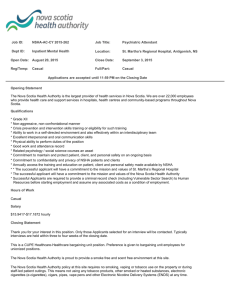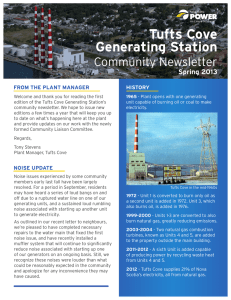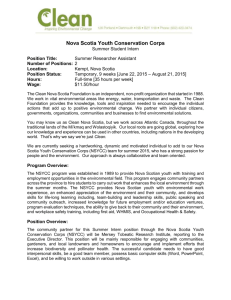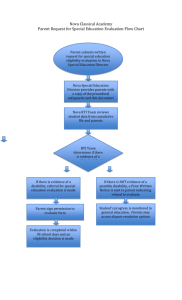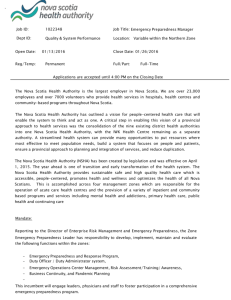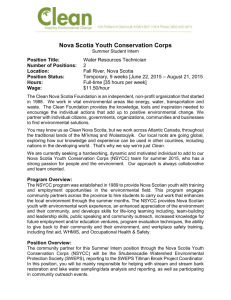NS-Moratorium-Cover-Letter - National Wind Watch | Resource
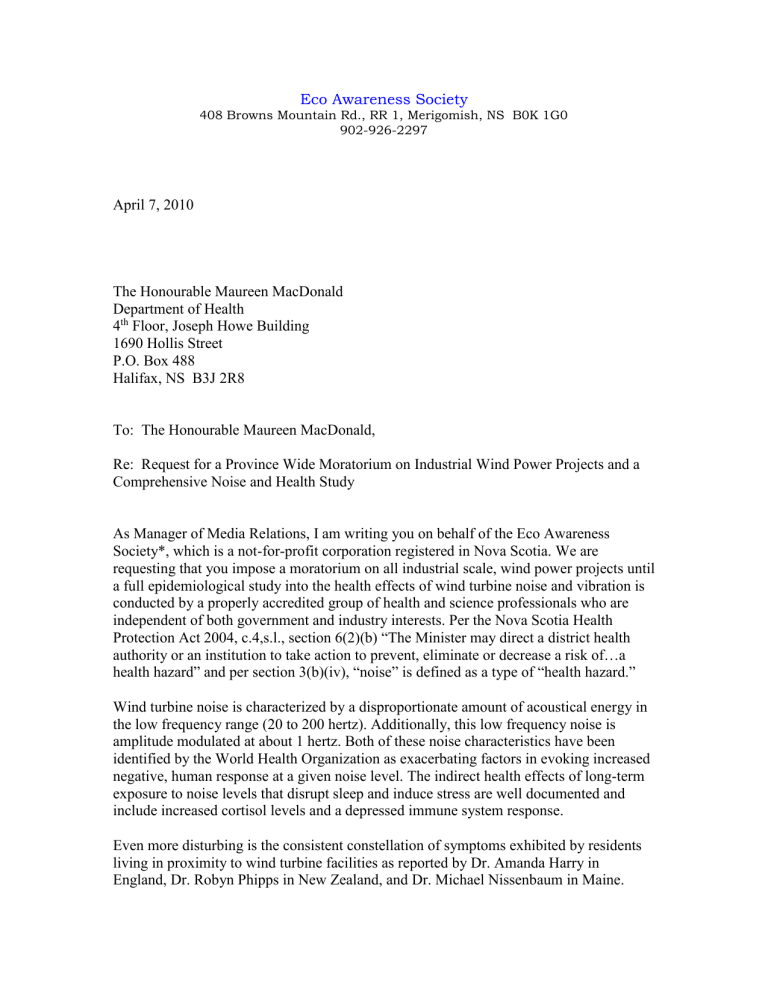
Eco Awareness Society
408 Browns Mountain Rd., RR 1, Merigomish, NS B0K 1G0
902-926-2297
April 7, 2010
The Honourable Maureen MacDonald
Department of Health
4 th
Floor, Joseph Howe Building
1690 Hollis Street
P.O. Box 488
Halifax, NS B3J 2R8
To: The Honourable Maureen MacDonald,
Re: Request for a Province Wide Moratorium on Industrial Wind Power Projects and a
Comprehensive Noise and Health Study
As Manager of Media Relations, I am writing you on behalf of the Eco Awareness
Society*, which is a not-for-profit corporation registered in Nova Scotia. We are requesting that you impose a moratorium on all industrial scale, wind power projects until a full epidemiological study into the health effects of wind turbine noise and vibration is conducted by a properly accredited group of health and science professionals who are independent of both government and industry interests. Per the Nova Scotia Health
Protection Act 2004, c.4,s.l., section 6(2)(b) “The Minister may direct a district health authority or an institution to take action to prevent, eliminate or decrease a risk of…a health hazard” and per section 3(b)(iv), “noise” is defined as a type of “health hazard.”
Wind turbine noise is characterized by a disproportionate amount of acoustical energy in the low frequency range (20 to 200 hertz). Additionally, this low frequency noise is amplitude modulated at about 1 hertz. Both of these noise characteristics have been identified by the World Health Organization as exacerbating factors in evoking increased negative, human response at a given noise level. The indirect health effects of long-term exposure to noise levels that disrupt sleep and induce stress are well documented and include increased cortisol levels and a depressed immune system response.
Even more disturbing is the consistent constellation of symptoms exhibited by residents living in proximity to wind turbine facilities as reported by Dr. Amanda Harry in
England, Dr. Robyn Phipps in New Zealand, and Dr. Michael Nissenbaum in Maine.
These symptoms, which include migraines, vertigo, dizziness, tachycardia, ear pressure, nausea, visual blurring, sleep disturbance and problems with concentration and memory have been collectively identified as “Wind Turbine Syndrome” by Dr. Nina Pierpont, whose book, “Wind Turbine Syndrome: A Report on a Natural Experiment” outlines a plausible explanation involving stimulation of the inner ear. The wind industry’s attempt to dismiss these worldwide reports of health effects from wind turbines as anecdotal is irresponsible. All research surrounding any health issue begins with case reports such as these and the “precautionary principal” mandates that further studies be done. As further evidence, we are providing you with Dr. Pierpont’s book as well as over 140 documents that both testify to the very real human suffering and report on investigations that both substantiate and explain the adverse human impacts.
Other governmental jurisdictions are taking heed of this expanding body of evidence and are reacting responsibly.
Japan is conducting a 4 year study into the health effects of wind turbines, specifically looking into low frequency noise
The government of Scotland requires setbacks of at least 2 km
Vermont has recently introduced a bill – H.677 – that “provides reasonable, clinically and scientifically-based protections against noise, vibration, and shadow flicker from industrial turbines.” This bill is being applauded worldwide for its comprehensive nature and the research that went into the bill to provide set back and noise levels in accordance with the most recent, independent research on this subject.
Unfortunately, here in Nova Scotia, Nova Scotia Environment (NSE) has routinely dismissed the concerns of residents who are facing industrial, wind power projects.
Although repeatedly presented with evidence of adverse health impacts and flaws in proponent noise studies that significantly underestimate noise levels, NSE continues to approve wind project assessments without any comment on the problems raised. In addition, by failing to require documented monitoring criteria and mitigation measures
(as required by the Nova Scotia Proponent’s Guide to Wind Power Projects), NSE has left residents to bear all the risks from industrial wind power projects.
Where is the peer-reviewed science that shows no harm will come to people living in close proximity to industrial wind power projects? Why are wind companies not given the burden to prove that their facility will do no harm? The push for renewable energy must not be at the expense of Nova Scotian’s health and wellbeing.
You have both the authority and the responsibility to impose a moratorium on all industrial wind power projects until such time that credible research can establish parameters for designing wind facilities in a manner that protects the health and well being of surrounding communities.
Respectfully,
Susan Overmyer, Manager, Media Relations
Eco Awareness Society
Representing the Members of the Eco Awareness Society
Cc:
Corey Simpson, Environmental Assessment Officer, Natural Resources Canada
Sheila Cole, Environmental Health Association of Nova Scotia
Bruce Wark, Freelance Journalist
Ralph Surette, Freelance Journalist
Rachel Brighton, Coastlands Magazine
*The Eco Awareness Society is a non-profit organization whose mission is to uphold these principles: that
“a subset of society should not be forced to bear the cost of a benefit for the larger society”, that a landowner’s right to full use and enjoyment of their property be upheld and not taken or hindered for public or private use or development, without just compensation, and that any policy or development with regard to the environment and landscape of Nova Scotia be shown to be effective and based on the principals of environmental sustainability and stewardship of our precious resources.**
**Based on the Canadian Charter of Rights and the Fifth Amendment, U.S. Constitution
